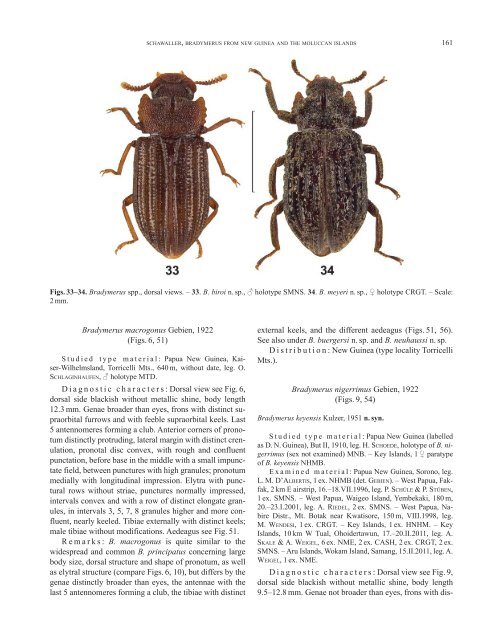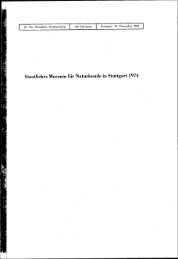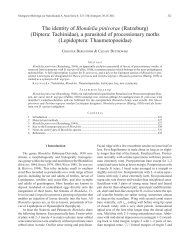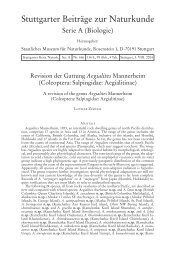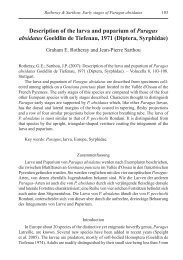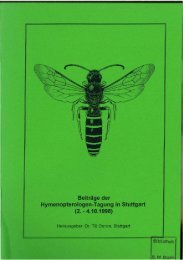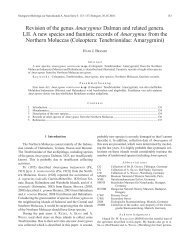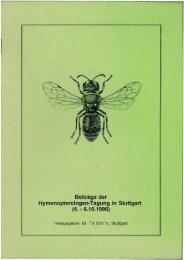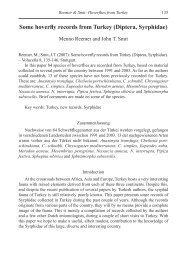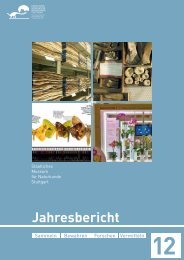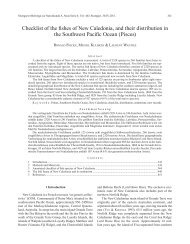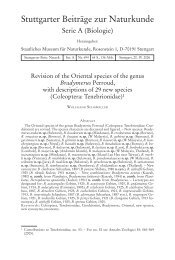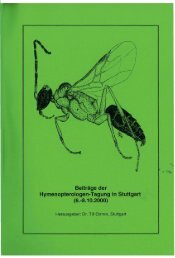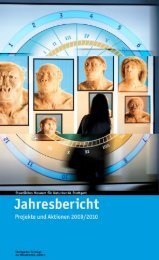The species of Bradymerus Perroud (Coleoptera: Tenebrionidae ...
The species of Bradymerus Perroud (Coleoptera: Tenebrionidae ...
The species of Bradymerus Perroud (Coleoptera: Tenebrionidae ...
You also want an ePaper? Increase the reach of your titles
YUMPU automatically turns print PDFs into web optimized ePapers that Google loves.
SCHAWALLER, BRADYMERUS FROM NEW GUINEA AND THE MOLUCCAN ISLANDS 161Figs. 33–34. <strong>Bradymerus</strong> spp., dorsal views. – 33. B. biroi n. sp., ♂ holotype SMNS. 34. B. meyeri n. sp., ♀ holotype CRGT. – Scale:2 mm.<strong>Bradymerus</strong> macrogonus Gebien, 1922(Figs. 6, 51)Studied type material: Papua New Guinea, Kaiser-Wilhelmsland,Torricelli Mts., 640 m, without date, leg. O.SCHLAGINHAUFEN, ♂ holotype MTD.Diagnostic characters: Dorsal view see Fig. 6,dorsal side blackish without metallic shine, body length12.3 mm. Genae broader than eyes, frons with distinct supraorbitalfurrows and with feeble supraorbital keels. Last5 antennomeres forming a club. Anterior corners <strong>of</strong> pronotumdistinctly protruding, lateral margin with distinct crenulation,pronotal disc convex, with rough and confluentpunctation, before base in the middle with a small impunctatefield, between punctures with high granules; pronotummedially with longitudinal impression. Elytra with puncturalrows without striae, punctures normally impressed,intervals convex and with a row <strong>of</strong> distinct elongate granules,in intervals 3, 5, 7, 8 granules higher and more confluent,nearly keeled. Tibiae externally with distinct keels;male tibiae without modifications. Aedeagus see Fig. 51.Remarks: B. macrogonus is quite similar to thewidespread and common B. principatus concerning largebody size, dorsal structure and shape <strong>of</strong> pronotum, as wellas elytral structure (compare Figs. 6, 10), but differs by thegenae distinctly broader than eyes, the antennae with thelast 5 antennomeres forming a club, the tibiae with distinctexternal keels, and the different aedeagus (Figs. 51, 56).See also under B. buergersi n. sp. and B. neuhaussi n. sp.Distribution: New Guinea (type locality TorricelliMts.).<strong>Bradymerus</strong> nigerrimus Gebien, 1922(Figs. 9, 54)<strong>Bradymerus</strong> keyensis Kulzer, 1951 n. syn.Studied type material: Papua New Guinea (labelledas D. N. Guinea), But II, 1910, leg. H. SCHOEDE, holotype <strong>of</strong> B. nigerrimus(sex not examined) MNB. – Key Islands, 1 ♀ paratype<strong>of</strong> B. keyensis NHMB.Examined material: Papua New Guinea, Sorono, leg.L. M. D’ALBERTIS, 1 ex. NHMB (det. GEBIEN). – West Papua, Fakfak,2 km E airstrip, 16.–18.VII.1996, leg. P. SCHÜLE & P. STÜBEN,1 ex. SMNS. – West Papua, Waigeo Island, Yembekaki, 180 m,20.–23.I.2001, leg. A. RIEDEL, 2 ex. SMNS. – West Papua, NabireDistr., Mt. Botak near Kwatisore, 150 m, VIII.1998, leg.M. WENDESI, 1 ex. CRGT. – Key Islands, 1 ex. HNHM. – KeyIslands, 10 km W Tual, Ohoidertawun, 17.–20.II.2011, leg. A.SKALE & A. WEIGEL, 6 ex. NME, 2 ex. CASH, 2 ex. CRGT, 2 ex.SMNS. – Aru Islands, Wokam Island, Samang, 15.II.2011, leg. A.WEIGEL, 1 ex. NME.Diagnostic characters: Dorsal view see Fig. 9,dorsal side blackish without metallic shine, body length9.5–12.8 mm. Genae not broader than eyes, frons with dis-


